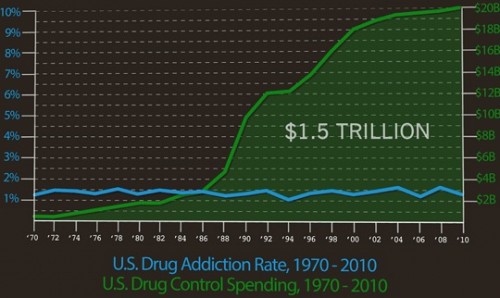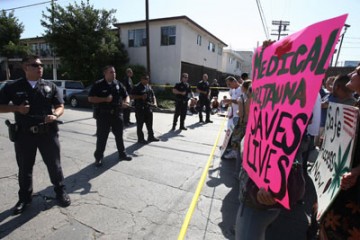DEA Judge Rules on the Safety of Marijuana

In 1988 there was a petition filed to reschedule marijuana from Schedule 1. Administrative Law Judge Francis L. Young examined the evidence related to the dangers of marijuana. His findings were quite telling. Tragically, they were also ignored by the DEA and marijuana remains classified as a dangerous Schedule 1 drug, more dangerous than cocaine, meth or Oxycodone even to this day.
Here’s a sample of his findings:
Is Marijuana Safe? DEA Judge Francis L. Young
“In strict medical terms marijuana is far safer than many foods we commonly consume. For example, eating 10 raw potatoes can result in a toxic response. By comparison, it is physically impossible to eat enough marijuana to induce death. Marijuana in its natural form is one of the safest therapeutically active substances known to man. By any measure of rational analysis marijuana can be safely used within the supervised routine of medical care.”
– DEA Administrative Law Judge Francis L. Young – 1988
Read is his entire summary:
UNITED STATES DEPARTMENT OF JUSTICE
Drug Enforcement Administration
_______________________________________
)
In The Matter Of )
) Docket No. 86-22
MARIJUANA RESCHEDULING PETITION )
_______________________________________)
OPINION AND RECOMMENDED RULING, FINDINGS OF
FACT, CONCLUSIONS OF LAW AND DECISION OF
Administrative LAW JUDGE.
FRANCIS L. YOUNG, Administrative Law Judge
DATED: SEP 6 1988
FRANCIS L. YOUNG, Administrative Law Judge
……………………
Part VIII.
ACCEPTED SAFETY FOR USE UNDER MEDICAL SUPERVISION
With respect to whether or not there is “a lack of accepted safety
for use of [marijuana] under medical supervision”, the record shows the
following facts to be uncontroverted.
Findings of Fact
Point 3. The most obvious concern when dealing with drug safety is the possibility of lethal effects. Can the drug cause death?
4. Nearly all medicines have toxic, potentially lethal effects. But marijuana is not such a substance. There is no record in the extensive medical literature describing a proven, documented cannabis-induced fatality.
5. This is a remarkable statement. First, the record on marijuana encompasses 5,000 years of human experience. Second, marijuana is now used daily by enormous numbers of people throughout the world. Estimates suggest that from twenty million to fifty million Americans routinely, albeit illegally, smoke marijuana without the benefit of direct medical supervision. Yet, despite this long history of use and the extraordinarily high numbers of social smokers, there are simply no credible medical reports to suggest that consuming marijuana has caused a single death.
6. By contrast aspirin, a commonly used, over-the-counter medicine, causes hundreds of deaths each year.
7. Drugs used in medicine are routinely given what is called an LD-50. The LD-50 rating indicates at what dosage fifty percent of test animals receiving a drug will die as a result of drug induced toxicity. A number of researchers have attempted to determine marijuana’s LD-50 rating in test animals, without success. Simply stated, researchers have been unable to give animals enough marijuana to induce death.
8. At present it is estimated that marijuana’s LD-50 is around 1:20,000 or 1:40,000. In layman terms this means that in order to induce death a marijuana smoker would have to consume 20,000 to 40,000 times as much marijuana as is contained in one marijuana cigarette. NIDA-supplied marijuana cigarettes weigh approximately .9 grams. A smoker would theoretically have to consume nearly 1,500 pounds of marijuana within about fifteen minutes to induce a lethal response.
9. In practical terms, marijuana cannot induce a lethal response as a result of drug-related toxicity.
10. Another common medical way to determine drug safety is called the therapeutic ratio. This ratio defines the difference between a therapeutically effective dose and a dose which is capable of inducing adverse effects.
11. A commonly used over-the-counter product like aspirin has a therapeutic ratio of around 1:20. Two aspirins are the recommended dose for adult patients. Twenty times this dose, forty aspirins, may cause a lethal reaction in some patients, and will almost certainly cause gross injury to the digestive system, including extensive internal bleeding.
12. The therapeutic ratio for prescribed drugs is commonly around 1:10 or lower. Valium, a commonly used prescriptive drug, may cause very serious biological damage if patients use ten times the recommended (therapeutic) dose.
13. There are, of course, prescriptive drugs which have much lower therapeutic ratios. Many of the drugs used to treat patients with cancer, glaucoma and multiple sclerosis are highly toxic. The therapeutic ratio of some of the drugs used in antineoplastic therapies, for example, are regarded as extremely toxic poisons with therapeutic ratios that may fall below 1:1.5. These drugs also have very low LD-50 ratios and can result in toxic, even lethal reactions, while being properly employed.
14. By contrast, marijuana’s therapeutic ratio, like its LD-50, is impossible to quantify because it is so high.
15. In strict medical terms marijuana is far safer than many foods we commonly consume. For example, eating ten raw potatoes can result in a toxic response. By comparison, it is physically impossible to eat enough marijuana to induce death.
16. Marijuana, in its natural form, is one of the safest therapeutically active substances known to man. By any measure of rational analysis marijuana can be safely used within a supervised routine of medical care.”
 Download his findings in PDF format.
Download his findings in PDF format.





No Comment